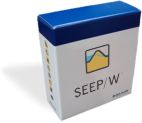SEEP/W 地下水滲流分析軟體

SEEP/W軟件是一款用於分析多孔滲水材料,如土體和岩石中的地下水滲流和超孔隙水壓力消散問題的有限元軟體。它的功能全面而簡潔,使用戶可以分析從簡單的、飽和穩態問題到複雜的、飽和.不飽和時變問題
SEEP/W is a finite element software product for analyzing groundwater seepage and excess pore-water pressure dissipation problems within porous materials such as soil and rock. Its comprehensive formulation allows you to consider analyses ranging from simple, saturated steady-state problems to sophisticated, saturated-unsaturated time-dependent problems. You can apply SEEP/W to the analysis and design of geotechnical, civil, hydrogeological, and mining engineering projects.
SEEP/W can model both saturated and unsaturated flow, a feature that greatly broadens the range of problems that can be analyzed. In addition to traditional steady-state saturated flow analysis, the saturated/unsaturated formulation of SEEP/W makes it possible to analyze seepage as a function of time and to consider such processes as the infiltration of precipitation. The transient feature allows you to analyze such problems as the migration of a wetting front and the dissipation of excess pore-water pressure.
Defining a Seepage/Air flow Model
The unique CAD-like technology in SEEP/W allows you to generate your finite element mesh by drawing regions on the screen. You can then interactively apply boundary conditions and specify material properties. You can even estimate the material property functions from easily measured parameters like grain-size, saturated conductivity, saturated water content, and the air-entry value. If you make a mistake, you can correct it using the Undo command.
Viewing the Analysis Results
Once you have solved your seepage problem, SEEP/W offers many tools for viewing results. Generate contours or x-y plots of any computed parameter, such as head, pressure, gradient, velocity, and conductivity. Velocity vectors show flow direction and rate. Transient conditions can be shown as the changing water table position over time. Interactively query computed values by clicking on any node, Gauss region, or flux section. Then export results into other applications, such as Microsoft Excel or Word, for further analysis or to prepare presentations.
SEEP/W can model almost any groundwater problem, including:
- Dissipation of excess pore pressure after reservoir drawdown
- Changes in pore-water pressure conditions within earth slopes due to infiltration of precipitation
- Mounding of the groundwater table beneath water retention structures such as lagoons and tailings ponds
- Effect of subsurface drains and injection wells
- Drawdown of a water table due to pumping from an aquifer
- Seepage flow quantities into excavations
- Use AIR/W and consider the true matric suction (Ua-Uw) mechanisms
- Integrate with TEMP/W and consider flow in freezing and thawing soils


